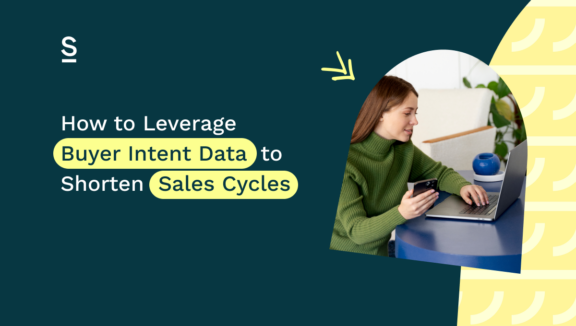How to Leverage Buyer Intent Data to Shorten Sales Cycles

How many deals would you rather close next month? Your usual amount, or your usual amount plus one or two or three?
No, this isn’t a trick question – we’re asking because there’s a way. And it starts with shortening your sales cycles.
Shorten your sales cycles, and you’ll be able to fit more wins into each month. More wins each month, more money for your business (and for you).
Ok, sold. So how do we do it? Well, you can speed up your sales cycles in two ways:
- Study mind-reading
- Start using buyer intent data
Assuming that you don’t have a local mind-reading teacher on speed dial (hit us up if you do), it looks like the second route’s going to be the one you take.
It’s not going to be a lonely journey, though – you’ve got us right with you! In this article, we’re going to show you why using buyer intent data is crucial to closing deals quickly and efficiently. We’ll take a look at what buyer intent data is, where to find it, what’s so great about it, and how your team can make it actionable and reap the rewards.
Highlights coming your way:
The basics: what is buyer intent data?
Buyer intent data refers to the signals that show a potential customer is considering a purchase. These signals are found in their online behaviour; things like website visits, content downloads and search queries.
By keeping an eye on these signals, your team can spot prospects who are further along in the buying journey, which in turn makes engagement easier. For example, it means you can send the perfectly formatted outreach message, with the exact messaging required, to the right contact, at the perfect moment. Or answer a prospect’s objection before they’ve even voiced it.
It’s kind of the equivalent of hitting a bullseye with every interaction: don’t blame us if everyone starts calling you Phil Taylor.
Types of buyer intent data
There are two types of buyer intent data:
First-party data is the information you collect in direct interactions with your prospects. You’ll get it from your website, CRM or email interactions.
Third-party data is information you’ve found from external sources like data providers or industry-specific platforms.
To properly use buyer intent data, you’ll want to use a combination of both. Why? Well, it’s essential to a well-rounded view of your audience. You need to know what they’re doing at all times (while they’re searching for your solution, we’re not that creepy), otherwise you’re only getting half the picture.
Think about it this way. A hot lead might start replying to your emails. Bingo! Sale’s in the bag – or is it? Spot that they’re also engaging with a competitor’s content on LinkedIn, and you’ll understand you’ve got a bit more work to do. Plus, you’ll know that at some point you’ll probably have to explain to them why to choose you over said competitor.
Where to find Buyer Intent Data
There are several places to find buyer intent data:
Internal sources
Website analytics: tracking what visitors get up to on your website can tell you exactly what products or services they’re interested in. For example, if a lead repeatedly visits a particular product page and then jumps over to a pricing page, that’s a pretty strong signal for you.
CRM systems: integrating buyer intent signals with your CRM makes sure that every interaction is as best informed as it could be. This doesn’t have to be complicated, either. A good tool – like oh, I don’t know, Surfe? – should integrate automatically with your CRM.
Email marketing tools: these are a goldmine. Keep an eye on email opens, clicks and responses to understand what impression you’re making. For example, if you’re testing a new message and getting nothing back, you should switch to another pain point or use case.
External sources
Intent data providers: there are loads to choose from here – companies like Bombora, TechTarget and G2 are industry leaders. Whichever tool you use, it should integrate with your CRM as standard. We’re in 2024 – manual data transfer just shouldn’t be a thing anymore.
Social media platforms: keep an eye on what your prospects engage with and who they talk to on LinkedIn and Twitter. You’ll be able to glean their interests, struggles, hopes and fears (maybe not that last one) and use them to your professional advantage.
Industry reports and publications: keep an eye on trends and topics of interest in industry publications. For example, if some new legislation comes in that’s going to make your prospects’ lives harder, you could reach out with helpful content. Or if your sector’s getting a lot of VC money (think AI) then you know you’re probably in a better position to push for a sale.

How can you use buyer intent data?
Buyer intent data is like a Swiss army knife – it’s got loads of different uses:
Prioritizing leads: use intent data to cherry-pick the most promising leads, and put them at the top of your priority list. You’ve only got so many hours in the day – make sure you’re spending them on the right people.
Personalizing outreach: write personalised messages and create offers based on the interests and behaviours of your prospect. In the world of B2B sales, you’re likely to be working on more than one person. Each person you talk to is going to care about slightly different things. For example, a more junior team member might care about how your tool makes their life easier. Their team leader’s going to want to present great ROI to the C-suite. And so on.
Optimizing outreach campaigns: the only constant in the world of B2B sales is change. You’ve got to make sure every campaign you send out is up-to-the-minute – otherwise it’s just not going to feel relevant to your high-intent prospects.
Enhancing sales conversations: equip yourself and your team with relevant insights to nail those pitches. Remember the example we used earlier about knowing when an objection is going to come up? This is your chance to stay super-well prepared and on the ball.

Integrating buyer intent data into your workflows
Ok, you’ve had a comprehensive (if we do say so ourselves) intro to buyer intent data. Now let’s talk about how to use it in your day-to-day:
Integrate it with your CRM systems
This is essential. Your day just isn’t going to move quickly or efficiently if you’re constantly having to manually transfer intent data into your CRM. This should be done automatically so you can make sure every insight you use is totally up-to-date.
Surfe is a good one to have in your arsenal here. Use it to sync LinkedIn activity – like finding new prospect contact data, or sending a killer outreach message – with major CRMs like HubSpot, Salesforce and Pipedrive.
Automate alerts and notifications:
Set up automated alerts to be notified when a prospect shows high buying intent. After all, as much as you are you can’t keep up with every single person you’re thinking about selling to ever. May as well make life easy for yourself where you can.
Surfe’s intelligent enrichment cascade will spot and let you know when something exciting happens – like a promotion or job change. This can be incredibly helpful when it comes to your activity. If a prospect gets a promotion, they might be more focussed on a metric your product helps push. Or if they move jobs, you’ll want up-to-date contact details – particularly as this is a great excuse to reach out.
Sales and marketing alignment
Sales and marketing should be besties that help each other out, above all else. Use the data you’re learning to tell marketing what’s working and what’s not, and ask them for the buyer intent data they’re gathering from paid ads or website traffic. Just like the church and state pre-Henry VIII, you guys should have a symbiotic relationship.
Shortening Sales Cycles with Buyer Intent Data
Ok, let’s put it all together. How do you use buyer intent data to shorten sales cycles, and get more wins under your belt?
Identify ready-to-buy prospects: focus your efforts on prospects who are showing clear buying signals, and you’ll reduce the time spent on unqualified leads.
Reduce research time: with automated insights delivered to your CRM, you’ll spend less time figuring out what’s going on and more time acting on it.
Improve conversion rates: tailor outreach and pitches based on what the intent data’s telling you, and increase the likelihood of moving your prospects down the funnel.
Streamline follow-ups: use automated tools to make sure your follow-ups are hyper-relevant, and always hit your prospects’ inboxes at exactly the right time.
Let’s Wrap It Up!
What did you say? You’ve actually got a number for a local mind reader?
You know what – no thanks. Now we know how to find and use first- and third-party buyer intent data, we don’t think we need it. If you’ll excuse us, we’ve got some targets to go and beat 💅
Hey, look – a mind reader!
Or maybe not – maybe they’ve just got really good tools to help them gather buyer intent data. Surfe is one of those tools – hit the button below to get started in seconds, for free.
FAQs about buyer intent data
What is buyer intent data?
Buyer intent data is data that indicates a potential customer is thinking of making a purchase. There are two types of buyer intent data:
- First-party data is the information you collect from your business’s interactions with your prospects: you’ll find it in your website analytics, in your CRM or in your email analytics software.
- Third-party data is information from external sources: data providers or social media platforms, for example.
How to use intent data for sales?
Buyer intent data should be an integral part of every B2B sales strategy. Use it to:
- Prioritise leads: identify which leads are closest to closing, and make sure you’re spending the right amount of time on them.
- Personalising outreach: write messages based on the interests and behaviours of your prospect to increase the chances of engagement.
- Optimising outreach campaigns: ensure your campaigns are hyper-relevant and contain up-to-the-minute information, to make them as helpful as possible.
- Enhancing sales conversations: make sure you know what a prospect’s going to say before they say it – and have answers to any difficult questions prepped and ready to go.
How to determine buyer intent?
Use buyer intent data to determine buyer intent. A mixture of first- and third-party buyer intent data should paint a comprehensive picture of where your prospect is in the funnel, and what actions you can take to move them down it. You can source buyer intent data from your website, CRM, social media, and other third-party providers.
How data is used in an effective sales and marketing process?
An effective sales and marketing process is one where the two teams are perfectly aligned. Buyer intent data can help with this: sales teams can feed back what they find prospects are interested in, while marketing teams can feed back on campaigns and messages that are making an impact further down the funnel.
Where does buyer intent data come from?
Buyer intent data comes from first- and third-party sources. Ideally, you want to be sourcing your data from both types of source:
First-party sources: you’ll find first-party buyer intent data in your website analytics, in your CRM and in your outreach tools (such as email and LinkedIn, for example).
Third-party sources: third-party buyer intent data comes from providers like Bombora, TechTarget and G2, social media platforms and industry reports and publications.


